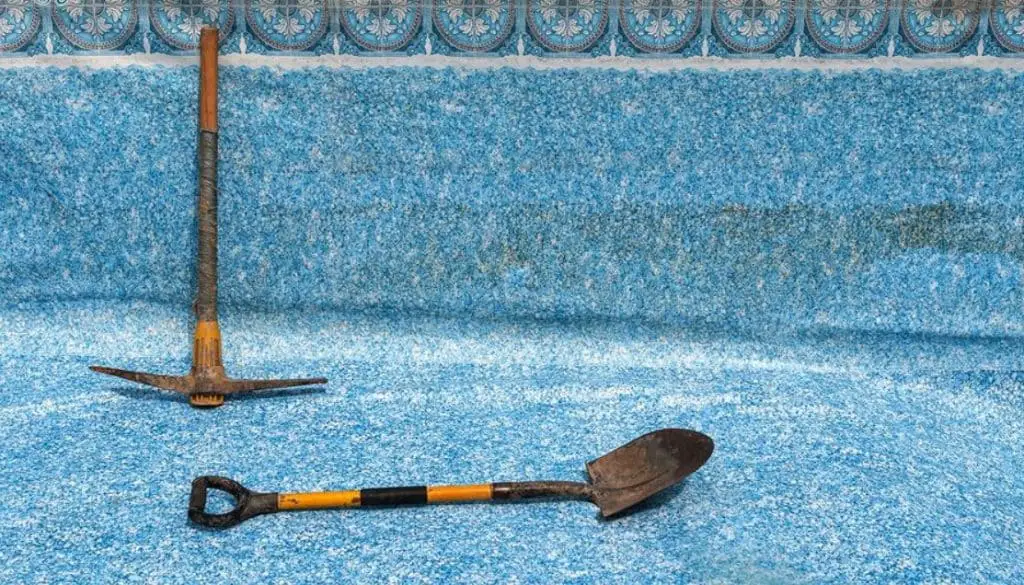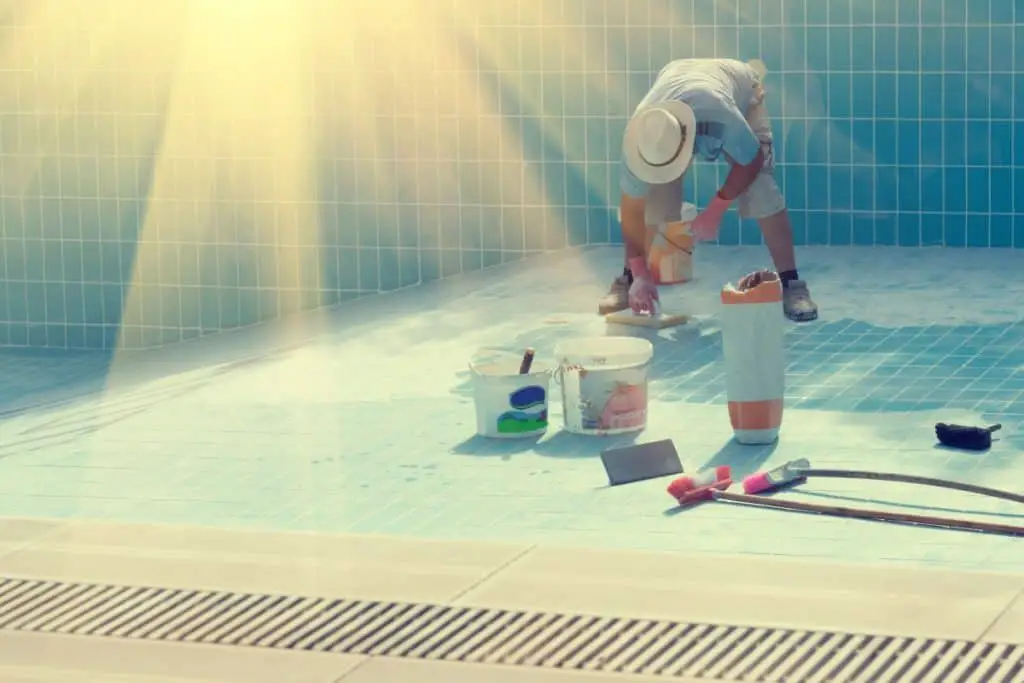
It is normal for the level of water to reduce in inground pools because of evaporation due to sunlight and humidity or during backwashing, but if you notice that your pool is losing more than ½ to 1 inch per day, then your pool most probably has a leak in it. A leak in your pool liner should definitely be fixed because it will not only empty the water in your pool, but it will also unnecessarily increase your energy bills and can also weaken the subsoil beneath your pool. Before you decide on how to repair the leak in your pool, you first need to identify the location and assess it right away.
A pool that leaks will often show signs of damage in and around the area of the leak. For instance, if you notice that your pool deck is sinking or have cracks in it, it could most probably mean that there is a leak there. Sometimes if there is rust around the return ports or skimmer it could be indicative of a leak. Also, check for liners that have previously been patched or see if you can find any cracks on the pool floor.
If you suspect a leak in your pool, here are some of the things that you can do to confirm it:
- Since pool leaks can be either inside or outside of the pool, a good idea to start with is to first check to see if there are any leaks in the equipment such as the filter, pump, heater, chlorinator and pipe valves.
- Check for any wet patches around the pool. The most common indication is wet soil and ground laden with moisture. Sometimes, the ground can even get eroded or sink in a bit.
- In case of a leak in a vinyl liner pool, check for separations and leaks in and around all the equipment such as the skimmers, fittings, the cleaner line, lights, steps, corners and returns.
- A good way to confirm a leak in your pool is by marking the level of water inside the pool using a tape or a grease pencil. If after 24 hours your pool has lost over ½” water, it is indicative of a leak.
- Another popular way to check for leaks is by placing a bucket that has pool water in it on one of the steps inside your pool. You can weigh it down with a brick or a rock. Ensure that the level of the pool water inside the bucket and in the pool are the same and at matching heights. After 24 hours, if the level of the water in the pool (outside the bucket) has dropped, it means that your pool has a leak in it. Conduct this test with the pump on as well as off.
You must observe the loss of water from the pool very diligently when the pump is in the on position and once when the pump is turned off. If you have turned the pump off and the level of the water changes even in the off position, this is indicative of a structural leak in your pool, in the plumbing system, and it has nothing to do with the pump.
How to Determine the Location of the Leak
- Once the leak is determined in your pool, you must turn off the filter system and take note of the point where the water does not drip anymore. Since vinyl liner pools need to always have water in them, you need to call a professional if you notice that the water is dropping very rapidly.
- The leak will probably be in the filtration system or skimmer if you notice that the water stops just at the very bottom of the skimmer opening. When your pool pump is running and if you notice any air bubbles in the water in the return line, this means that the filtration system has a leak in the suction side. Always make sure that the lid on the pump basket is secure and tightly placed and the O-ring lid is properly lubricated and in proper condition.
- If you notice that the water is stopping at the light, the light housing probably has the leak.
- In case the water starts dropping below the light, it may mean that there is a leak in the drain, located at the bottom of the pool.
- Sometimes, your pool may lose more water when the pump is running. In this case you should check the backwash line or waste line as the leak is most probably on the return line of the system.
- You must also check to see if there are tears, gaps or cracks in the skimmer, light or liner.
Using Food Color to Check for a Hole in the Vinyl Liner
If you suspect that the vinyl liner has a leak in it, here is what you can do to check!
- Make sure that the pool is filled up to the brim. This is to make sure that the leak is not above the level of the water.
- If you notice that the floor of the pool is a bit loose and squishy, it means that the bottom of your pool liner has a leak in it.
- You should place a few drops of food coloring in the areas that you suspect the leak.
- Continue to place food color all around your pool until you locate the leak.
- The color will enable you to see the flow of water and you will notice that the color flows out of your pool in the same spot where the leak is present.
How You Can Fix a Leak
If the leak is just a simple problem, you can easily fix the leak in a number of ways. For instance, if it is a skimmer leak, which means that the skimmer and pool have separated, thus creating a gap, you can just use pool putty to fix it.
Sometimes, the conduit pipe may break or come apart from the niche and this is rather difficult to mend. You can use putty, caulk, silicone or a two-part epoxy that hardens upon drying.
If the leak is linear, you can use a vinyl replacement liner and if the leak is under water then you need to use a wet patch kit to fix it. If the leak is very big, you should consider getting help from a professional.
When Should You Call a Professional?
Sometimes, locating the leak in your pool is very difficult and you will have to call in a professional to help. Depending upon the size and gravity of the leak, the cost that you will pay to a professional for the detection of a leak could be anything between $150 to $1,300, not including the charges for repairs.
If you have an inground pool, most often a professional will use compressed air to pressurize a pipe. This compressed air helps to displace the water that is present in the pipe until the point of the leak is reached. You will notice that bubbles start to escape from the hole, thus revealing the leak.
Alternatively, a special camera can be passed between the plumbing pipes in order to see the leak. Sometimes, technicians can electronically listen with the help of a special microphone, to the air escaping from a pipe after air has been injected into it.
Most often, a pool can have multiple leaks, thus making it even more difficult to locate the problem area. Even if one leak is easily discovered and repaired, you may find that water is still leaking from your pool, not expecting that there could be another leak or many more leaks in other parts of the pool. Sometimes leaks may also occur due to incorrect installation of the plumbing system or because of the use of inferior plumbing materials. In this case, it is best to get the plumbing lines replaced rather than repaired, as the leaks will only occur again and again and you will be spending more money in the long run on multiple repairs.
While trying to detect a leak in your pool, it is a good idea to take a note of all the experiments and procedures that you may have tried in order to find the leak. Even though you may not able to detect and repair the leak by yourself, it could help speed the process of leak detection for a professional, as most of the small tests that you conduct will be conducted by the professional too. Always be aware of the different parts and components of your pool and also of the condition of wear and tear so as to prevent the possibility of a leak at any point in time.
There are different professional pool related services in the market today. For instance, certain companies will only provide services for pool leak detection and other companies will only provide the repair for the leaks. Thus, when hiring a professional, be sure to make a proper inquiry regarding the services of the company that you engage in.


